The optical properties of crystals are, next to x-ray diffraction and
direct chemical analyses, the most reliable properties available to
distinguish and identify minerals.
The optical properties depend on the manner that visible light is transmitted through the crystal, and thus are dependent on crystal structure, crystal symmetry, and chemical composition of the mineral.
In order to understand the optical properties of crystals we must first understand something about light and how it interacts with matter.
The optical properties depend on the manner that visible light is transmitted through the crystal, and thus are dependent on crystal structure, crystal symmetry, and chemical composition of the mineral.
In order to understand the optical properties of crystals we must first understand something about light and how it interacts with matter.
Light
Light is electromagnetic radiation that has properties of
waves. The electromagnetic spectrum can be divided into several
bands based on the wavelength of the light waves. As we have discussed
before, visible light represents a narrow group of wavelengths
between about 380 nm (1 nm = 10-9 m) and 730 nm.
Our eyes interpret these wavelengths as different colors. If only
a single wavelength or limited range of wavelengths are present and enter
our eyes, they are interpreted as a certain color. If a single
wavelength is present we say that we have monochromatic light.
If all wavelengths of visible light are present, our eyes interpret this
as white light. If no wavelengths in the visible range are present,
we interpret this as dark.
Interaction of Light with Matter
Velocity of Light and Refractive IndexThe energy of light is related to its frequency and velocity as follows:
E = hn = hC/l
where E = energy
h = Planck's constant, 6.62517 x 10-27 erg.sec
n = frequency
C = velocity of light = 2.99793 x 1010 cm/sec
l = wavelength
h = Planck's constant, 6.62517 x 10-27 erg.sec
n = frequency
C = velocity of light = 2.99793 x 1010 cm/sec
l = wavelength
The velocity of light, C, in a vacuum is 2.99793 x 1010cm/sec.
Light cannot travel faster than this, but if it travels through a substance,
its velocity will decrease. Note that from the
equation given above-
C = nl
The frequency of vibration, n,
remains constant when the light passes through a substance. Thus,
if the velocity, C, is reduced on passage through a substance, the
wavelength, l, must also decrease.We here define refractive index, n, of a material or substance as the ratio of the speed of light in a vacuum, C, to the speed of light in a material through which it passes, Cm.
n = C/Cm
Note that the value of refractive index will always be
greater than 1.0, since Cm can never be
greater than C. In general, Cm depends on the density of the
material, with Cm decreasing with increasing
density. Thus,
higher density materials will have higher refractive
indices.
The refractive index of any material depends on the wavelength of light
because different wavelengths are interfered with to different extents by
the atoms that make up the material. In general refractive index varies
linearly with wavelength.
Materials can be divided into 2 classes based on how the
velocity of light of a particular wavelength varies in the
material.
- Materials whose refractive index not depend on the direction that the light travels are called irotropic materials. In these materials the velocity of light does not depend on the direction that the light travels. Isotropic materials have a single, constant refractive index for each wavelength. Minerals that crystallize in the isometric system, by virtue of their symmetry, are isotropic. Similarly, glass, gases, most liquids and amorphous solids are isotropic.
- Materials whose refractive index does depend on the direction that the light travels are called anisotropic materials. These types of materials will have a range of refractive indices between two extreme values for each wavelength. Anisotropic materials can be further divided into two subclasses, although the reasoning behind these subdivisions will become clear in a later lecture.
- Minerals that crystallize in the tetragonal and hexagonal crystal systems (as well as some plastics) are uniaxial and are characterized by 2 extreme refractive indices for each wavelength.
- Minerals that crystallize in the triclinic, monoclinic, and orthorhombic crystal systems are biaxial and are characterized by 3 refractive indices, one of which is intermediate between the other two.
Air, since it is a gas, is isotropic. The refractive index of air
is usually taken as 1.0, although its true value is 1.0003.
Reflection and Refraction of Light
When light strikes an interface between two substances with different
refractive indices, two things occur. An incident ray of light striking
the interface at an angle, i, measured between a line perpendicular to the
interface and the propagation direction of the incident ray, will be
reflected off the interface at the same angle, i. In other words the
angle of reflection is equal to the angle of incidence.
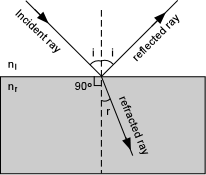 If the second substance is transparent to light, then a ray of light
will enter the substance with different refractive index, and will be
refracted, or bent, at an angle r, the angle of refraction. The
angle of refraction is dependent on the angle of incidence and the
refractive index of the materials on either side of the interface
according to Snell's Law:
If the second substance is transparent to light, then a ray of light
will enter the substance with different refractive index, and will be
refracted, or bent, at an angle r, the angle of refraction. The
angle of refraction is dependent on the angle of incidence and the
refractive index of the materials on either side of the interface
according to Snell's Law:
ni sin (i) = nr sin (r)
Note that if the angle of incidence is 0o (i.e. the light
enters perpendicular to the interface) that some of the light will be
reflected directly back, and the refracted ray will continue along the
same path. This can be seen from Snell's law, since sin(0o)
= 0, making sin (r) = 0, and resulting in r = 0.
There is also an angle, ic, called the critical angle for
total internal reflection where the refracted ray travels along
the interface between the two substances.
This occurs when the angle r = 90o. In this case,
applying Snell's law:
ni sin (ic) = nr sin (90o)
= nr [since sin (90o) = 1]
sin (ic) = nr/ni
Dispersion of Light
The fact that refractive indices differ for each wavelength of light
produces an effect called dispersion. This can be
seen
by shining a beam of white light into a triangular prism made of
glass. White light entering such a prism will be refracted in the prism
by
different angles depending on the wavelength of the light.
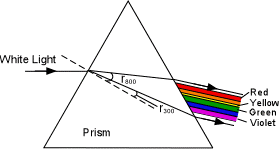 The
refractive index for longer wavelengths (red) are lower than those for
shorter wavelengths (violet). This results in the a greater angle of
refraction for the longer wavelengths than for the shorter
wavelengths. (Shown here are the paths taken for a wavelength of 800
nm, angle r800 and for a wavelength of 300 nm, angle r300
). When the light exits from the other side of the prism, we see the
different wavelengths dispersed to show the different colors of the
spectrum.
The
refractive index for longer wavelengths (red) are lower than those for
shorter wavelengths (violet). This results in the a greater angle of
refraction for the longer wavelengths than for the shorter
wavelengths. (Shown here are the paths taken for a wavelength of 800
nm, angle r800 and for a wavelength of 300 nm, angle r300
). When the light exits from the other side of the prism, we see the
different wavelengths dispersed to show the different colors of the
spectrum.
Absorption of Light
When light enters a transparent material some of its energy is dissipated
as heat energy, and it thus looses some of its intensity. When this absorption
of energy occurs selectively for different wavelengths of light, they
light that gets transmitted through the material will show only those
wavelengths of light that are not absorbed. The transmitted
wavelengths will then be seen as color, called the absorption color
of the material.
For example, if we measure the intensity of light, Io,
for each wavelength before it is transmitted through a material, and
measure the intensity, I, for each wavelength after it has passed through
the material, and plot I/Io versus wavelength we obtain the
absorption curve for that material as shown here. The
absorption curve (continuous line) for the material in this example shows
that the light exiting the material will have a yellow-green color, called
the absorption color. An opaque substance would have
an absorption curve such as that labeled "Dark", i.e. no
wavelengths would be transmitted. Sunlight, on passing through the
atmosphere has absorption curve as shown, thus we see it as white light,
since all wavelengths are present.
Polarization of Light
Normal light vibrates equally in all direction perpendicular to its
path of propagation. If the light is constrained to vibrate in only
on plane, however, we say that it is plane polarized light. The direction
that the light vibrates is called the vibration direction,
which for now will be perpendicular to the direction. There are two
common ways that light can become polarized.
- The first involves reflection off of a non-metallic surface, such as glass or paint. An unpolarized beam of light, vibrating in all directions perpendicular to its path strikes such a surface and is reflected. The reflected beam will be polarized with vibration directions parallel to the reflecting surface (perpendicular to the page as indicated by the open circles on the ray path). If some of this light also enters the material and is refracted at an angle 90o to the path of the reflected ray, it too will become partially polarized, with vibration directions again perpendicular to the path of the refracted ray, but in the plane perpendicular to the direction of vibration in the reflected ray (the plane of the paper, as shown in the drawing).
- Polarization can also be achieved by passing the light through a substance that absorbs light vibrating in all directions except one. Anisotropic crystals have this property in certain directions, called privileged directions, and we will discuss these properties when we discuss uniaxial and biaxial crystals. Crystals were used to produce polarized light in microscopes built before about 1950. The device used to make polarized light in modern microscopes is a Polaroid, a trade name for a plastic film made by the Polaroid Corporation. A Polaroid consists of long-chain organic molecules that are aligned in one direction an placed in a plastic sheet. They are placed close enough to form a closely spaced linear grid, that allows the passage of light vibrating only in the same direction as the grid. Light vibrating in all other directions is absorbed. Such a device is also called a polarizer.
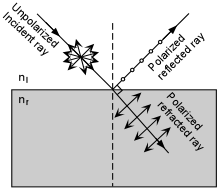
If a beam on non-polarized light encounters a polarizer, only light vibrating parallel to the polarizing direction of the polarizer will be allowed to pass. The light coming out on the other side will then be plane polarized, and will be vibrating parallel to the polarizing direction of the polarizer. If another polarizer with its polarization direction oriented perpendicular to the first polarizer is placed in front of the beam of now polarized light, then no light will penetrate the second polarizer. In this case we say that the light has been extinguished.
Polaroid sunglasses use these same principles. For example, incoming solar radiation is reflected off of the surface of the ocean or the painted hood of your car. Reflected light coming off of either of these surfaces will be polarized such that the vibration directions are parallel to the reflected surface, or approximately horizontal (as in the first method of polarization discussed above). Polaroid sunglasses contain polarizers with the polarization direction oriented vertically. Wearing such glasses will cut out all of the horizontally polarized light reflecting off the water surface or hood of your car.
source : http://www.tulane.edu/~sanelson/geol211/proplight.htm
youtube video






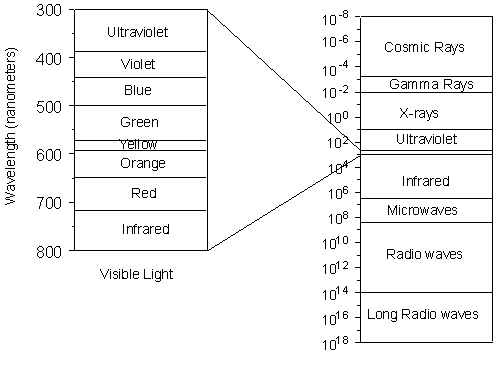
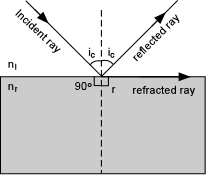
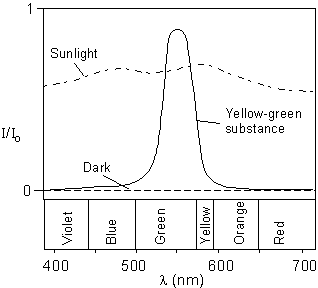
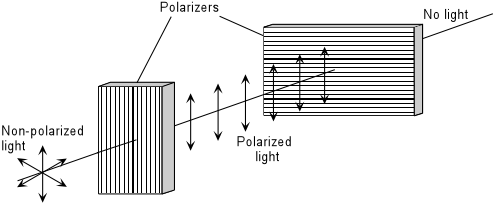






Link exchange is nothing else but it is only placing the other person's webpage link on your page at proper place and other person will also do same in support of you.
ReplyDeleteAlso visit my web page http://fastcashadvancepaydayloans.com/
Look at my blog post ; cash advances
Hi there! I realize this is kind of off-topic but I needed to ask.
ReplyDeleteDoes building a well-established blog like yours require a large amount of work?
I'm brand new to writing a blog but I do write in my journal daily. I'd like to start a blog so I will be able to share my personal
experience and views online. Please let me know if you have any
kind of ideas or tips for brand new aspiring bloggers.
Appreciate it!
Here is my page ... luxury real estate Rome Italy
My spouse and I stumbled over here from a different website and thought I might as well check things
ReplyDeleteout. I like what I see so now i am following you.
Look forward to going over your web page for a second time.
Visit my web blog ... internet
Wοw! Αfter all І got a blog fгоm whеrе I
ReplyDeleteκnow how tо really take vаluable informatiοn conсеrning my stuԁу and κnowledge.
Μy website: Tallahassee homes for sale
I am glad that the blog owner has chosen a very interesting matter in order to spread huge knowledge among people...I would like to congratulate for this hard work to the blog owner and would like to be part of his blog by submitting comments.
ReplyDeleteReal Estate